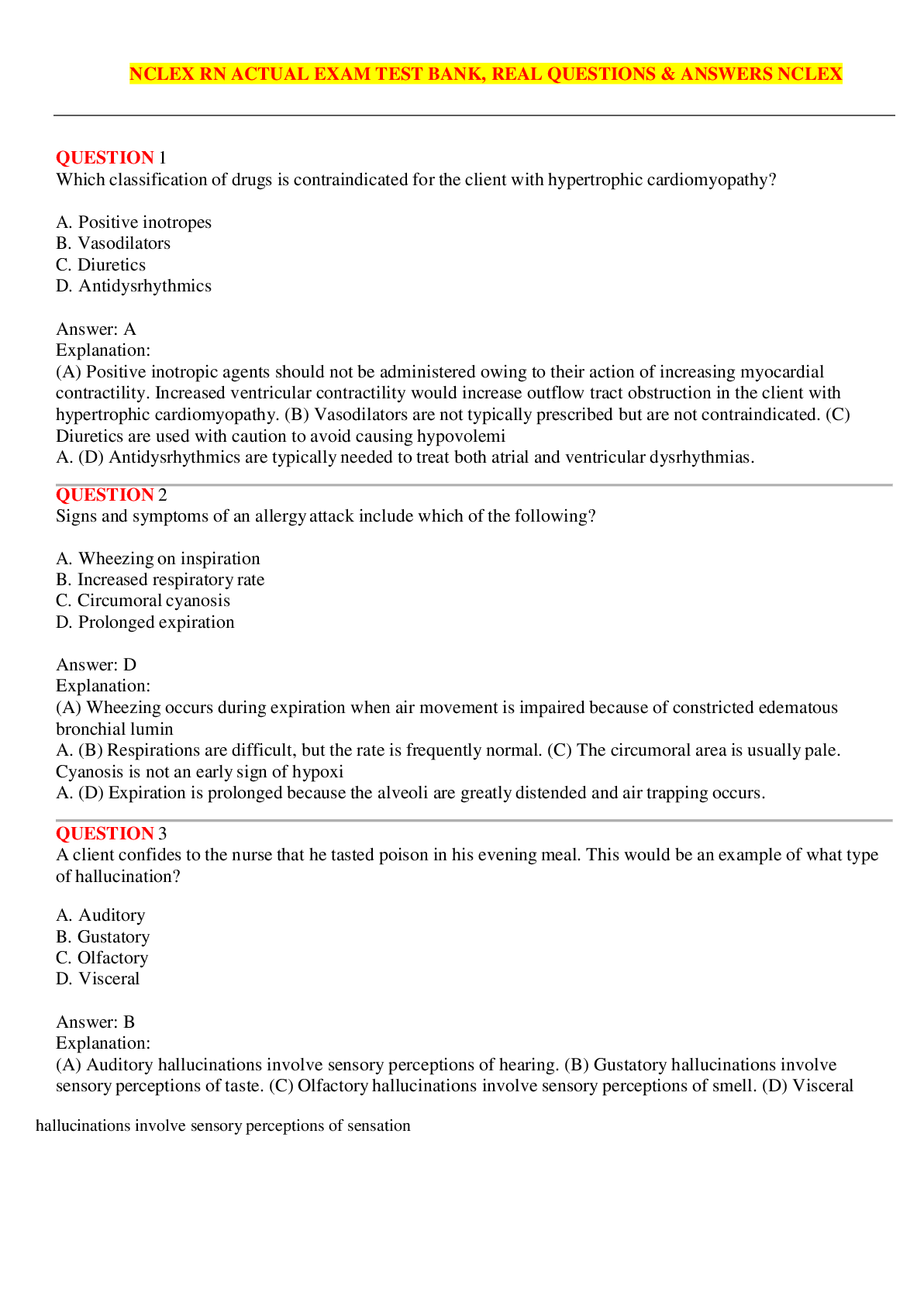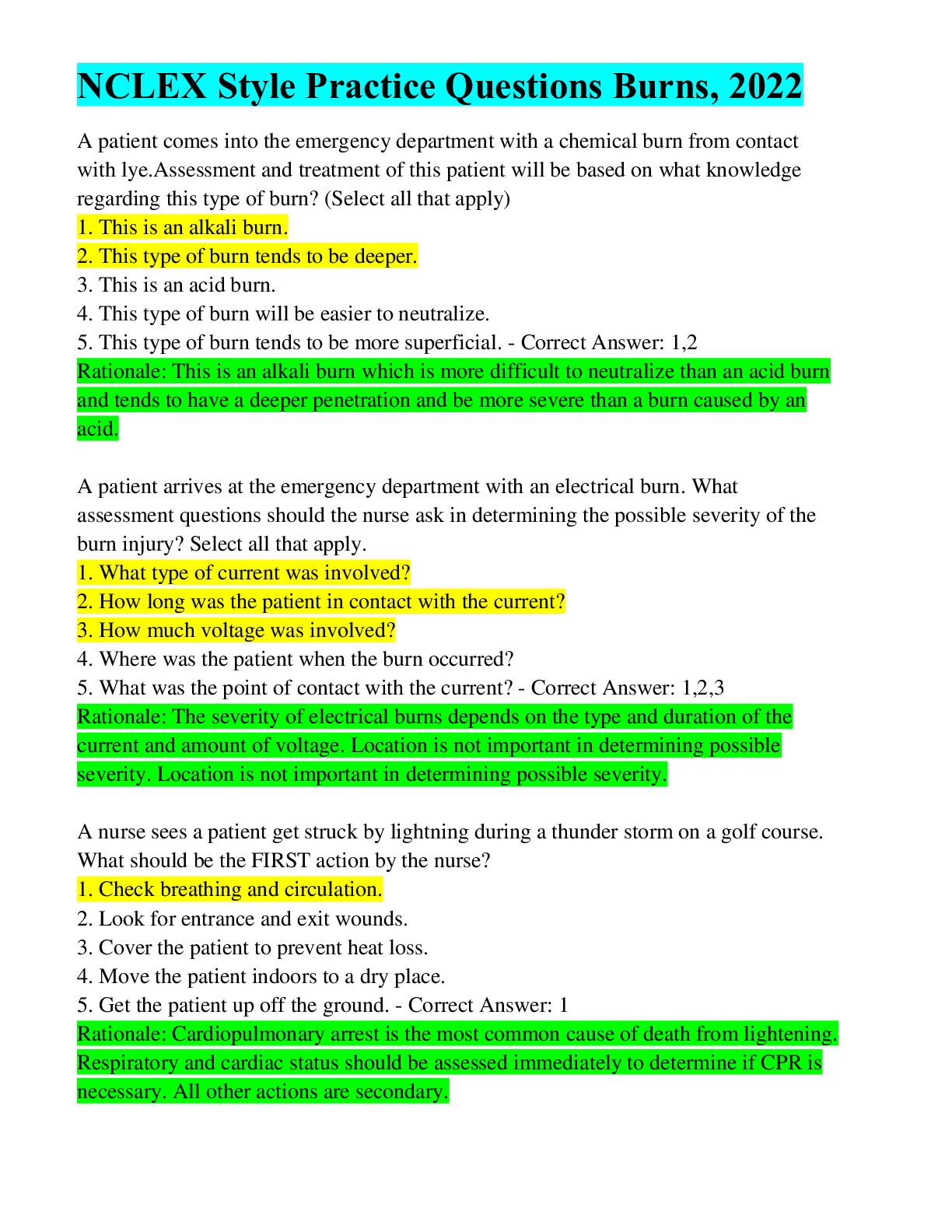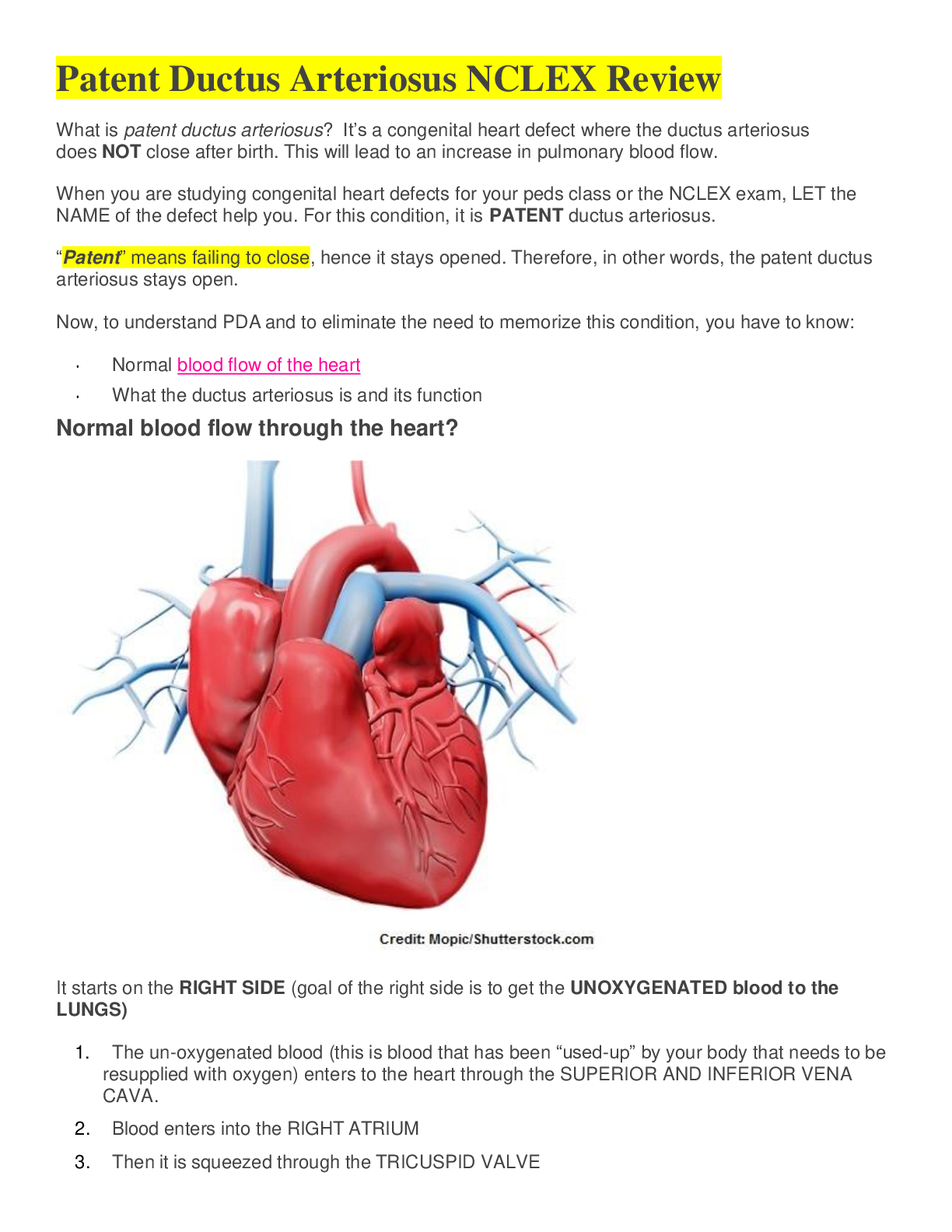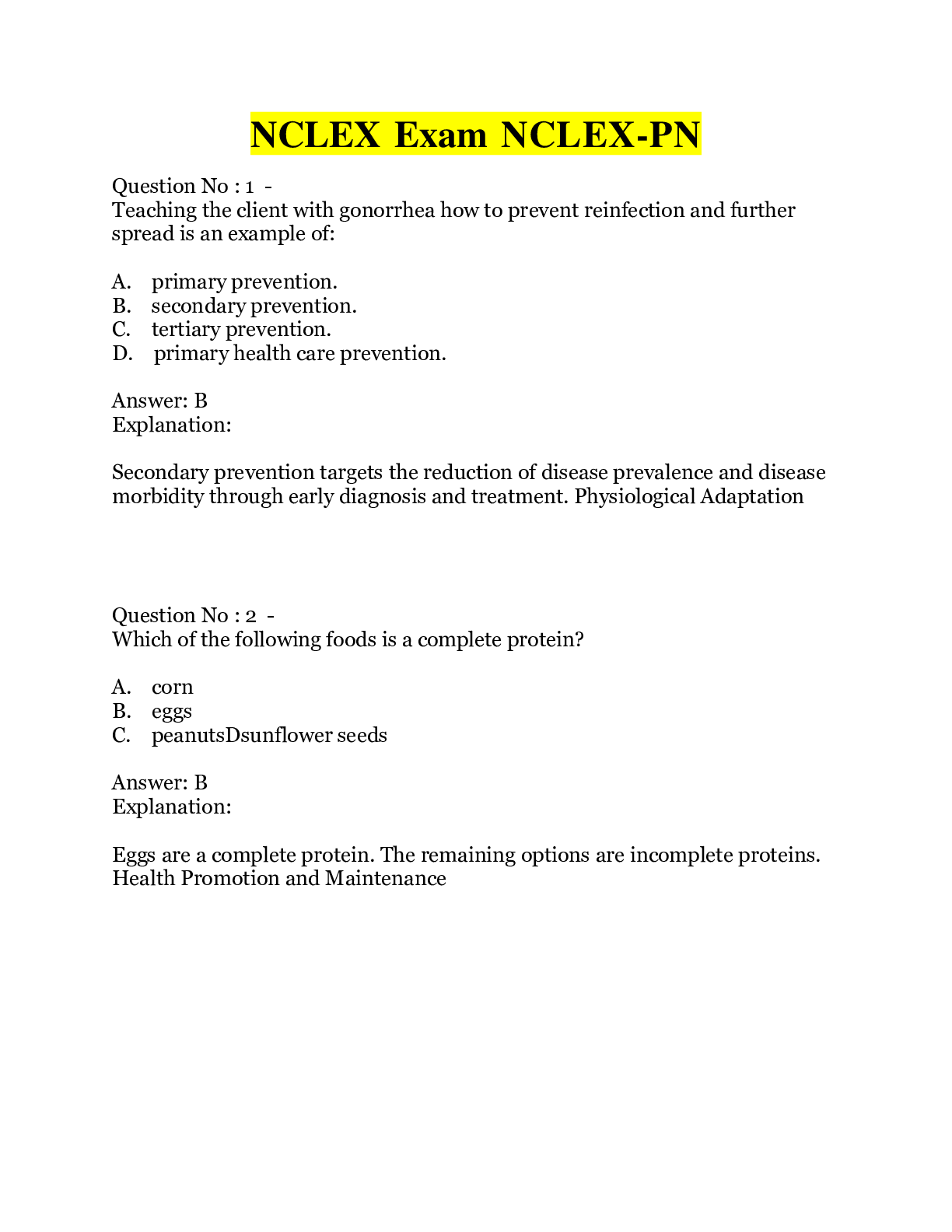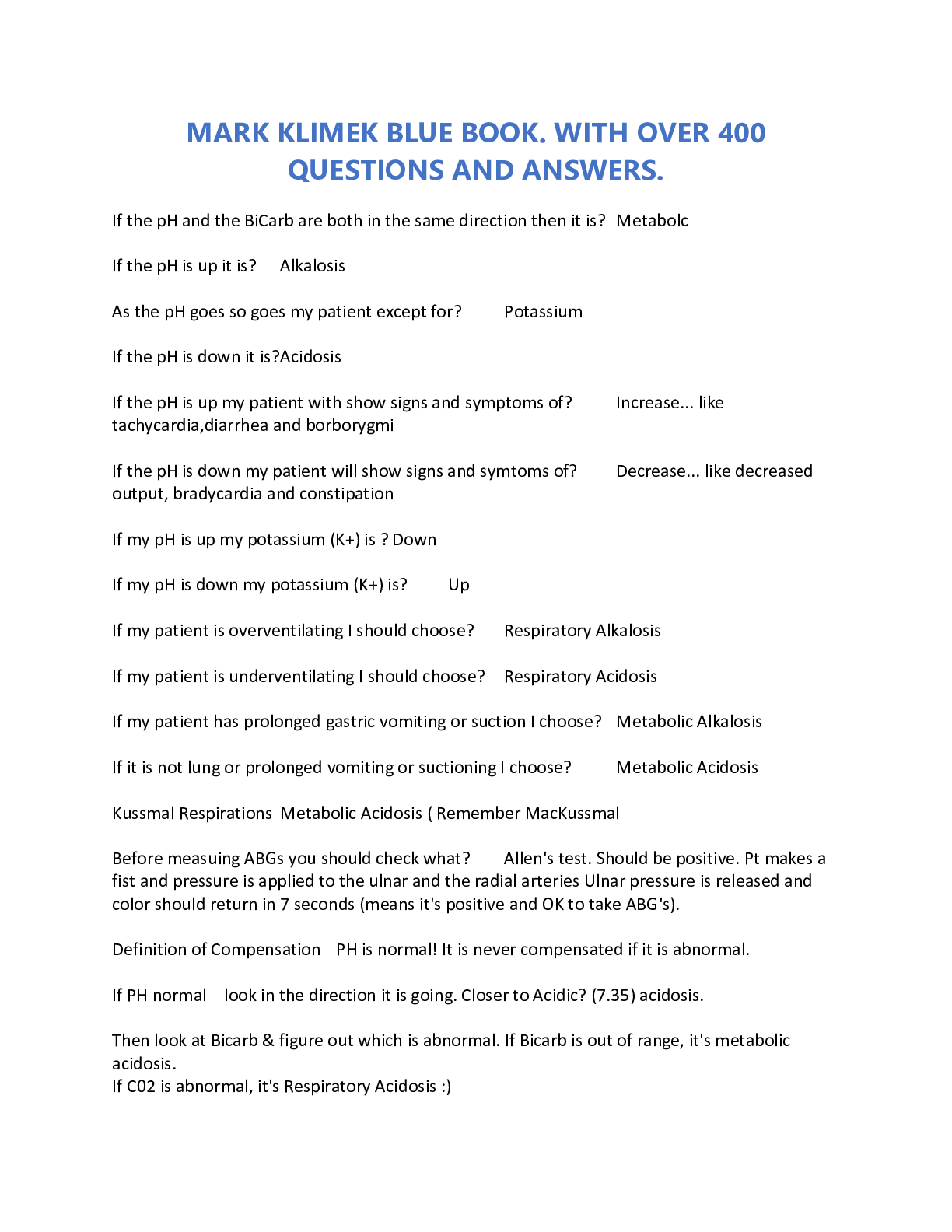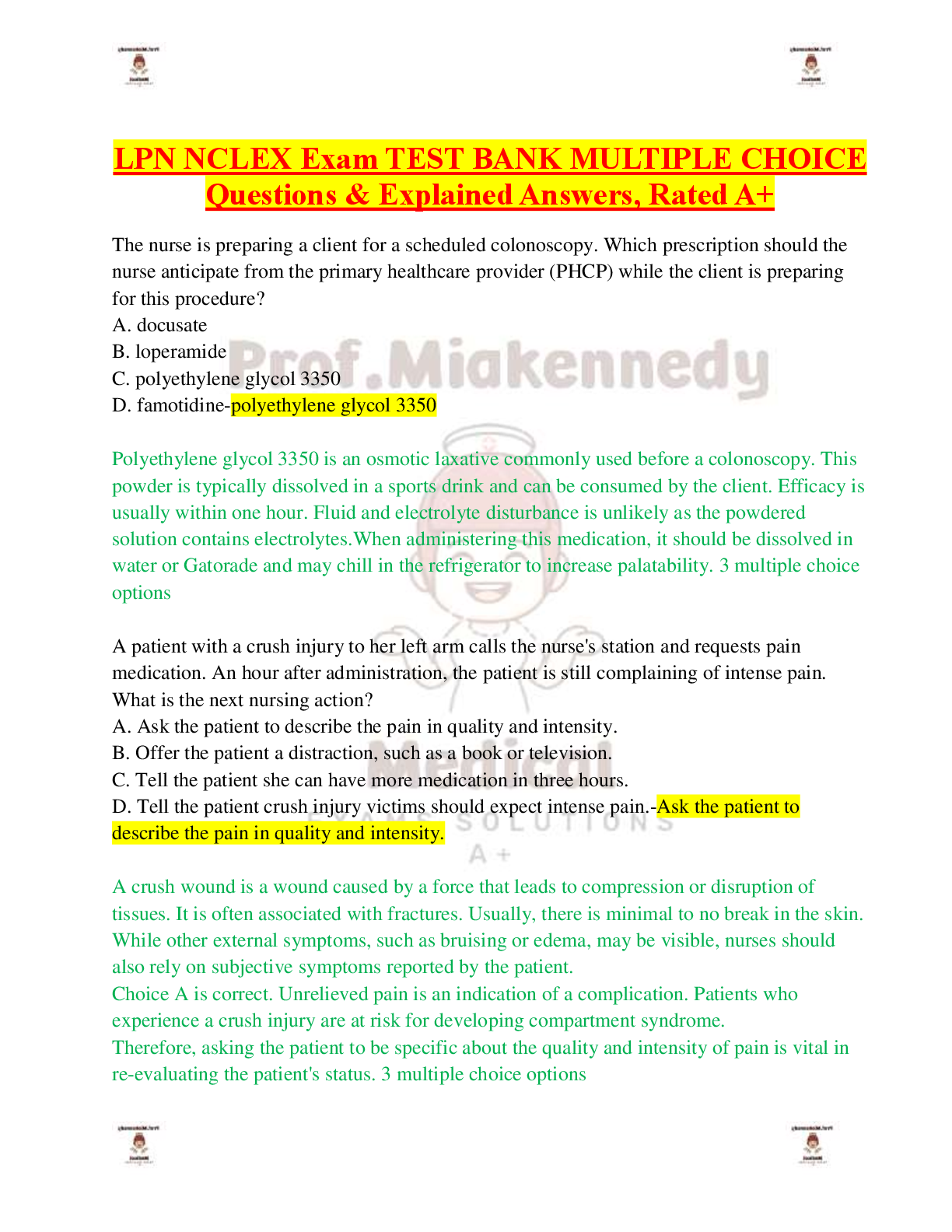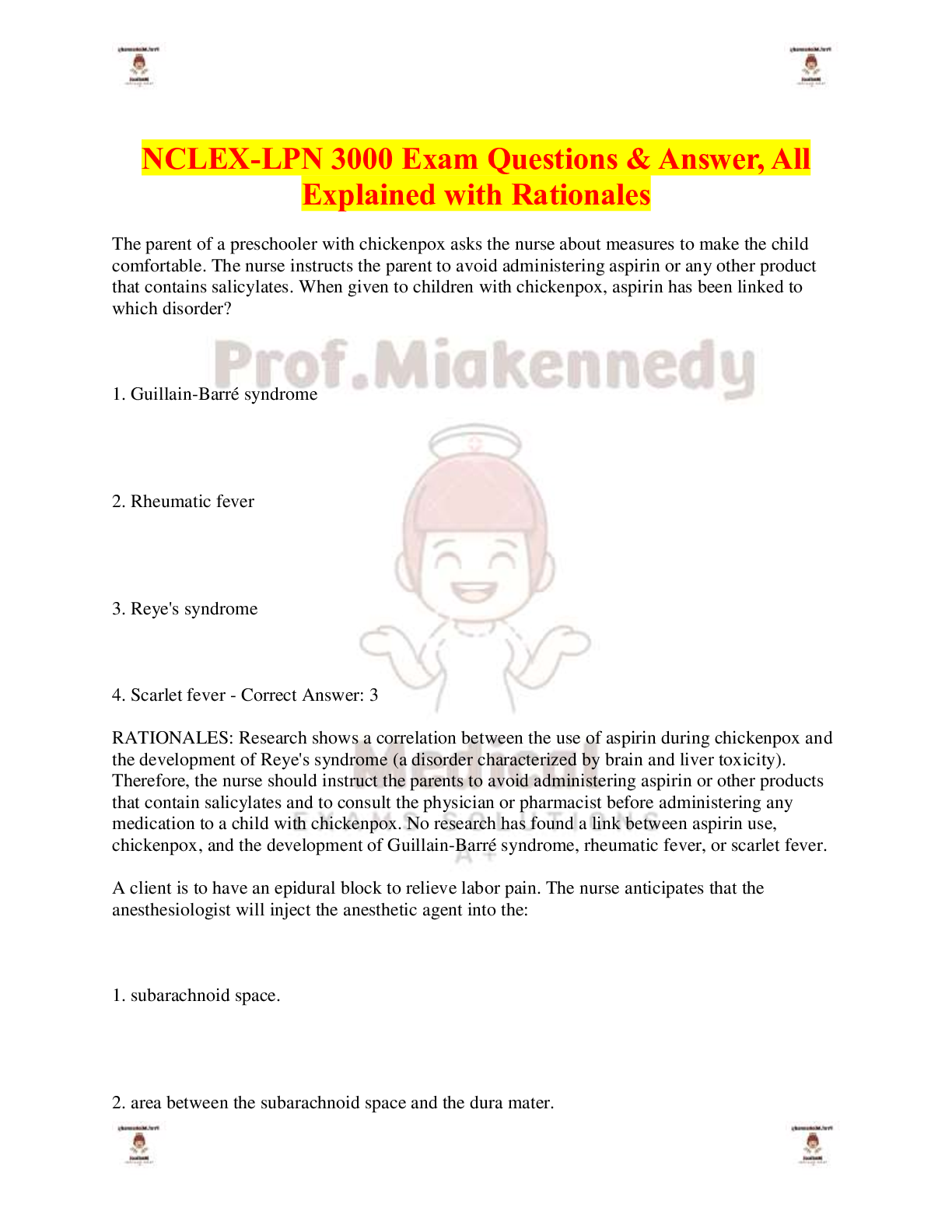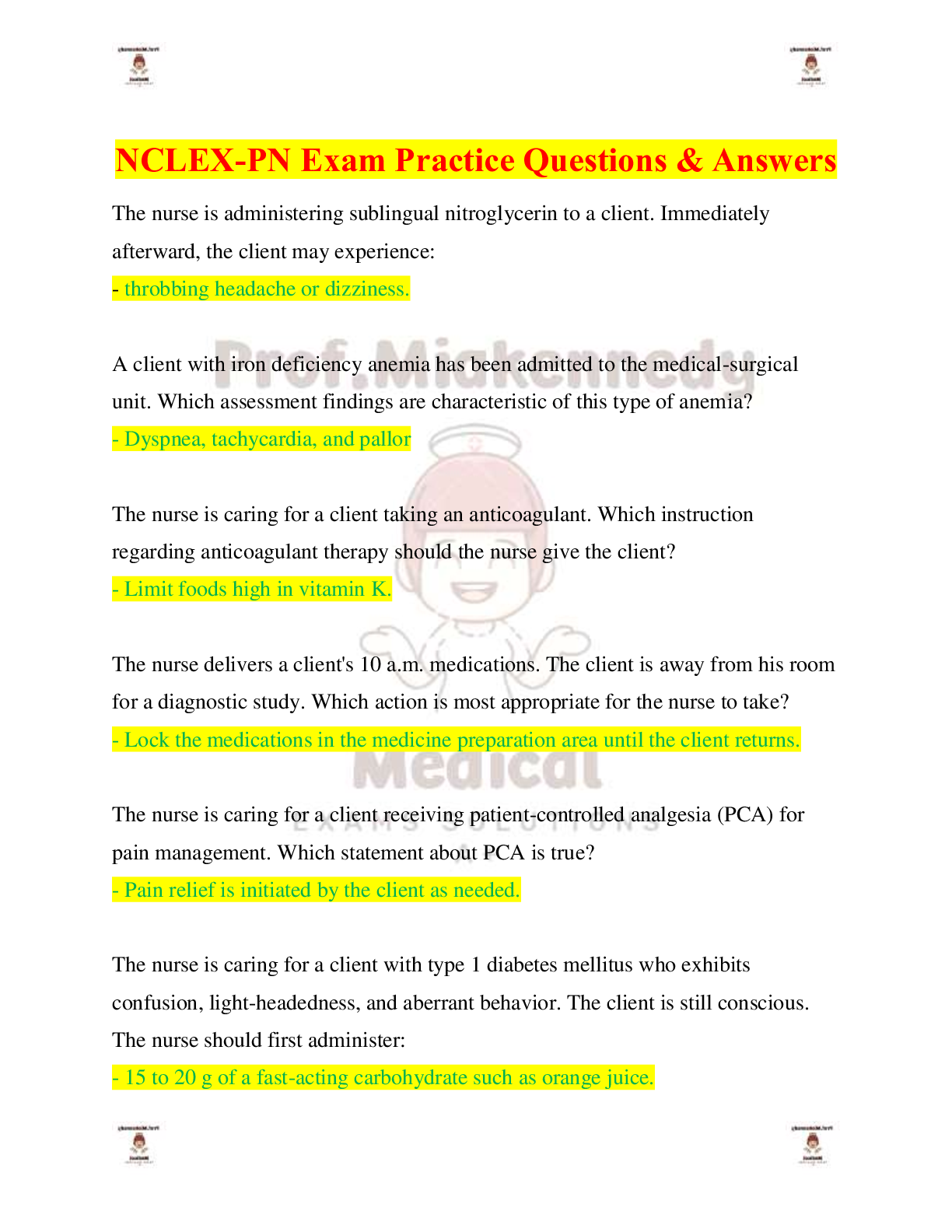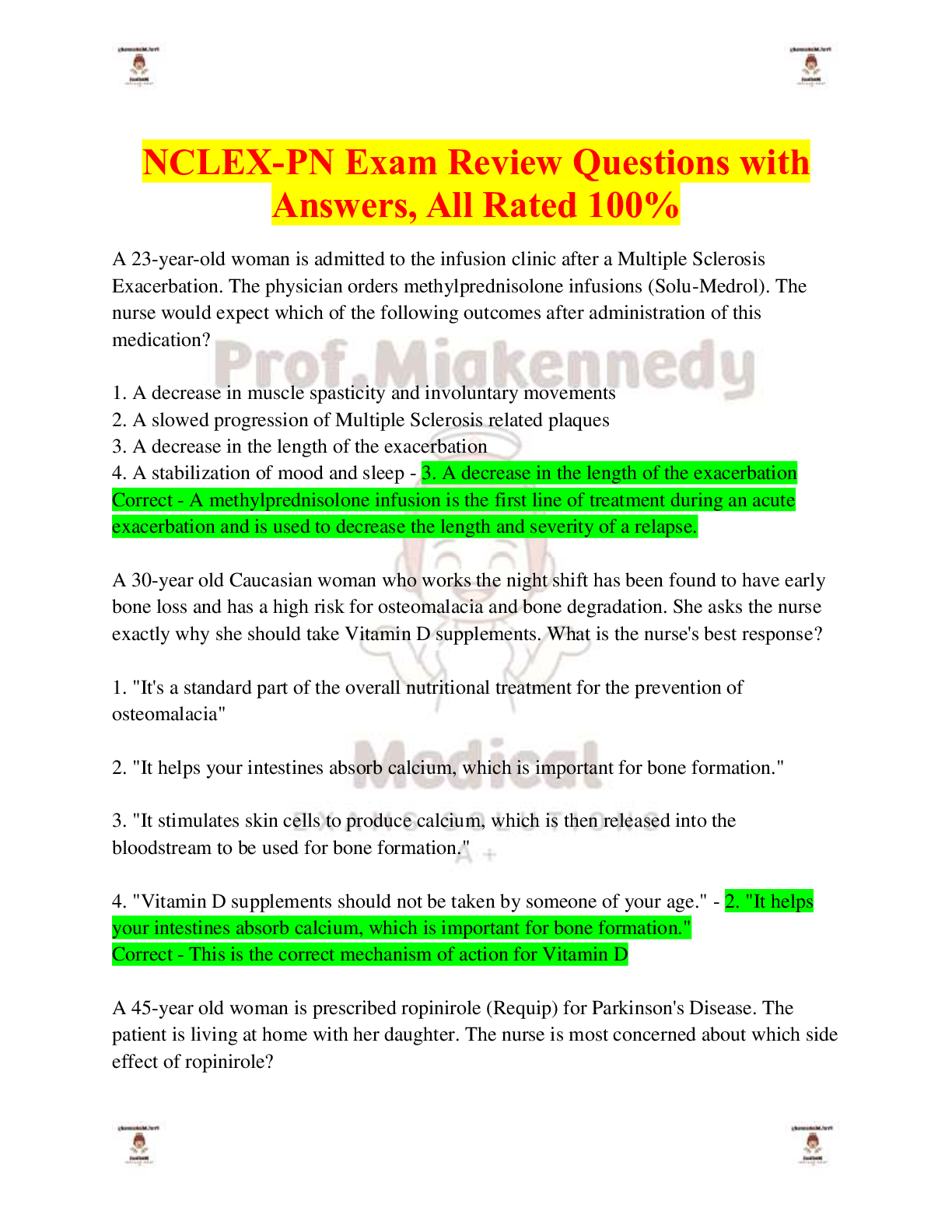CARDIAC NCLEX Exam Practice Questions & Answers, All Answered Correctly
Document Content and Description Below
CARDIAC NCLEX Exam Practice Questions & Answers, All Answered Correctly-Which of the following actions is the first priority of care for a pt exhibiting signs & symptoms of coronary artery disease? 1... . Decrease anxiety 2. Enhance myocardial oxygenation 3. Administer sublingual nitroglycerin 4. Educate the pt about his symptoms - 2. Enhancing myocardial oxygenation is always the first priority when a pt exhibits signs or symptoms of cardiac compromise. W/out adequate oxygenation, the myocardium suffers damage. Sublingual nitroglycerin is administered to treat acute angina, but administration isn't the first priority. Although educating the pt & decreasing anxiety are important in care delivery, neither are priorities when a pt is compromised. Medical treatment of coronary artery disease includes which of the following procedures? 1. Cardiac catherization 2. Coronary artery bypass surgery 3. Oral med therapy 4. Percutaneous transluminal coronary angioplasty - 3. Oral med administration is a noninvasive, medical treatment for coronary artery disease. Cardiac catherization isn't a treatment, but a diagnostic tool. Coronary artery bypass surgery & percutaneous transluminal coronary angioplasty are invasive, surgical treatments. Which of the following is the most common symptom of myocardial infarction (MI)? 1. Chest pain 2. Dyspnea 3. Edema 4. Palpitations - 1. The most common symptom of an MI is chest pain, resulting from deprivation of oxygen to the heart. Dyspnea is the second most common symptom, related to an increase in the metabolic needs of the body during an MI. Edema is a later sign of heart failure, often seen after an MI. Palpitations may result from reduced cardiac output, producing arrhythmias. Which of the following symptoms is the most likely origin of pain the pt described as knifelike chest pain that increases in intensity with inspiration? 1. Cardiac 2. Gastrointestinal 3. Musculoskeletal 4. Pulmonary - 4. Pulmonary pain is generally described by these symptoms. Musculoskeletal pain only increases w/ movement. Cardiac & GI pains don't change w/ respiration. Which of the following blood tests is most indicative of cardiac damage? 1. Lactate dehydrogenase 2. Complete blood count (CBC) 3. Troponin I 4. Creatine kinase (CK) - 3. Troponin I levels rise rapidly & are detectable w/in 1 hour of myocardial injury. Troponin I levels aren't detectable in people w/out cardiac injury. Lactate dehydrogenase (LDH) is present in almost all body tissues & not specific to heart muscle. LDH isoenzymes are useful in diagnosing cardiac injury. CBC is obtained to review blood counts, & a complete chemistry is obtained to review electrolytes. Because CK levels may rise w/ skeletal muscle injury, CK isoenzymes are required to detect cardiac injury What is the primary reason for administering morphine to a pt with an MI? 1. To sedate the pt 2. To decrease the pt's pain 3. To decrease the pt's anxiety 4. To decrease oxygen demand on the pt's heart - 4. Morphine is administered because it decreases myocardial oxygen demand. Morphine will also decrease pain & anxiety while causing sedation, but it isn't primarily given for those reasons. Which of the following conditions is most commonly responsible for myocardial infarction? 1. Aneurysm 2. Heart failure 3. Coronary artery thrombosis 4. Renal failure - 3. Coronary artery thrombosis causes an inclusion of the artery, leading to myocardial death. An aneurysm is an outpouching of a vessel & doesn't cause an MI. Renal failure can be associated w/ MI but isn't a direct cause. Heart failure is usually a result from an MI. Which of the following complications is indicated by a third heart sound (S3)? 1. Ventricular dilation 2. Systemic hypertension 3. Aortic valve malfunction 4. Increased atrial contractions - 1. Rapid filling of the ventricle causes vasodilation that is auscultated as S3. Increased atrial contraction or systemic hypertension can result in a fourth heart sound. Aortic valve malfunction is heard as a murmur. After an anterior wall myocardial infarction, which of the following problems is indicated by auscultation of crackles in the lungs? 1. Left-sided heart failure 2. Pulmonic valve malfunction 3. Right-sided heart failure 4. Tricupsid valve malfunction - 1. The left ventricle is responsible for most of the cardiac output. An anterior wall MI may result in a decrease in left ventricular function. When the left ventricle doesn't function properly, resulting in left-sided heart failure, fluid accumulates in the interstitial & alveolar spaces in the lungs & causes crackles. Pulmonic & tricuspid valve malfunction causes right sided heart failure. What is the first intervention for a pt experiencing MI? 1. Administer morphine 2. Administer oxygen 3. Administer sublingual nitroglycerin 4. Obtain an ECG - 2. Administering supplemental oxygen to the pt is the first priority of care. The myocardium is deprived of oxygen during an infarction, so additional oxygen is administered to assist in oxygenation & prevent further damage. Morphine & nitro are also used to treat MI, but they're more commonly administered after the oxygen. An ECG is the most common diagnostic tool used to evaluate MI. Which of the following classes of meds protects the ischemic myocardium by blocking catecholamines & sympathetic nerve stimulation? 1. Beta-adrenergic blockers 2. Calcium channel blockers 3. Narcotics 4. Nitrates - 1. Beta-adrenergic blockers work by blocking beta receptors in the myocardium, reducing the response to catecholamines & sympathetic nerve stimulation. They protect the myocardium, helping to reduce the risk of another infarction by decreasing myocardial oxygen demand. Calcium channel blockers reduce the workload of the heart by decreasing the heart rate. Narcotics reduce myocardial oxygen demand promote vasodilation, & decrease anxiety. Nitrates reduce myocardial oxygen consumption by decreasing left ventricular end-diastolic pressure (preload) & systemic vascular resistance (afterload). What is the most common complication of an MI? 1. Cardiogenic shock 2. Heart failure 3. arrhythmias 4. Pericarditis - 3. Arrhythmias, caused by oxygen deprivation to the myocardium, are the most common complication of an MI. Cardiogenic shock, another complication of an MI, is defined as the end stage of left ventricular dysfunction. This condition occurs in approximately 15% of pts w/ MI. Because the pumping function of the heart is compromised by an MI, heart failure is the second most common complication. Pericarditis most commonly results from a bacterial or viral infection but may occur after the MI. With which of the following disorders is jugular vein distention most prominent? 1. Abdominal aortic aneurysm 2. Heart failure 3. MI 4. Pneumothorax - 2. Elevated venous pressure, exhibited as jugular vein distention, indicates a failure of the heart to pump. JVD isn't a symptom of abdominal aortic aneurysm or pneumothorax. An MI, if severe enough, can progress to heart failure, however, in & of itself, an MI doesn't cause JVD. Toxicity from which of the following meds may cause a pt to see a green-yellow halo around lights? 1. Digoxin 2. Furosemide (Lasix) 3. Metoprolol (Lopressor) 4. Enalapril (Vasotec) - 1. One of the most common signs of digoxin toxicity is the visual disturbance known as the "green-yellow halo sign." The other meds aren't associated w/ such an effect. Which of the following symptoms is most commonly associated with left-sided heart failure? 1. Crackles 2. Arrhythmias 3. Hepatic engorgement 4. Hypotension - 1. Crackles in the lungs are a classic sign of left-sided heart failure. These sounds are caused by fluid backing up into the pulmonary system. Arrhythmias can be associated w/ both right- & left-sided heart failure. Left-sided heart failure causes hypertension secondary to an increased workload on the system. [Show More]
Last updated: 1 year ago
Preview 1 out of 22 pages
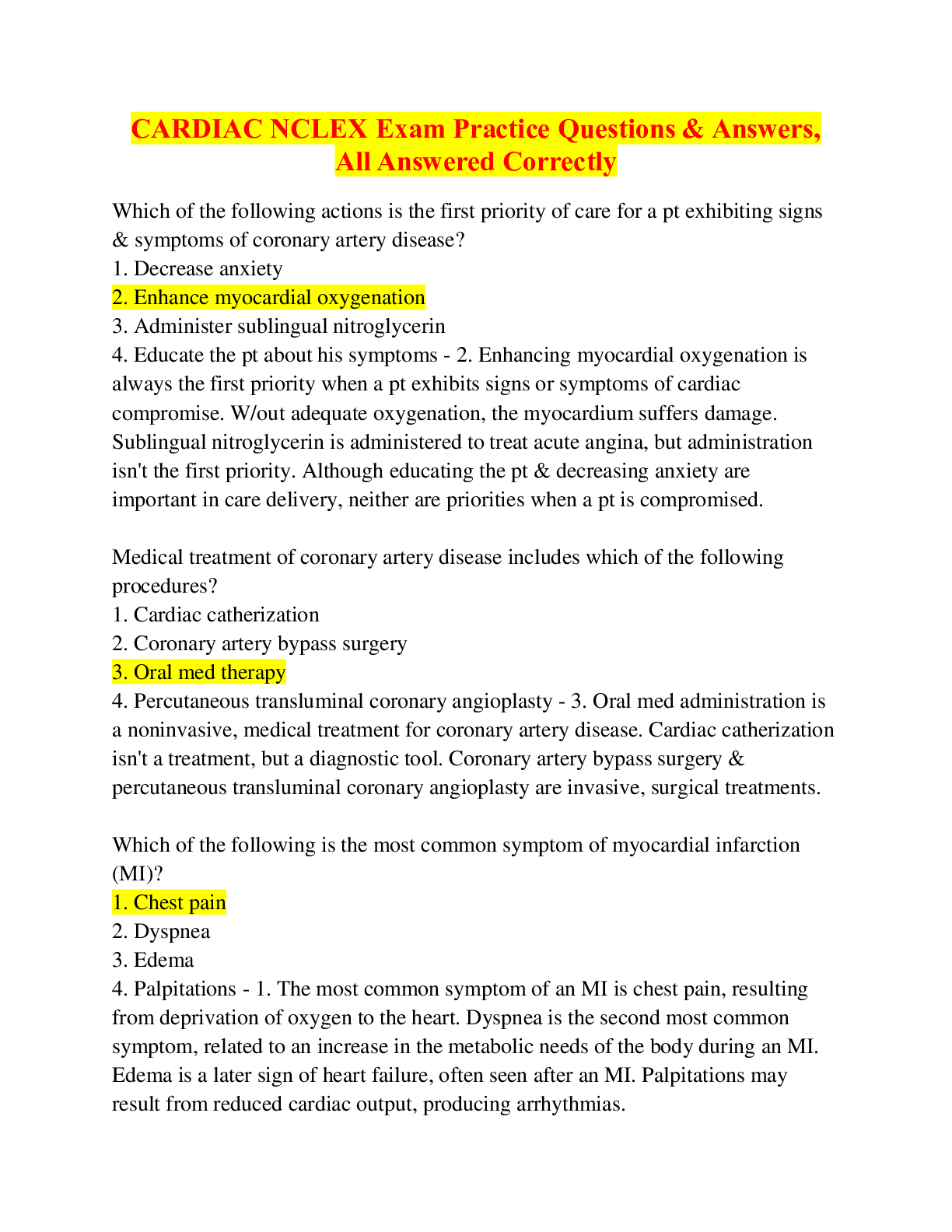
Buy this document to get the full access instantly
Instant Download Access after purchase
Buy NowInstant download
We Accept:

Reviews( 0 )
$13.50
Can't find what you want? Try our AI powered Search
Document information
Connected school, study & course
About the document
Uploaded On
Jan 31, 2024
Number of pages
22
Written in
Additional information
This document has been written for:
Uploaded
Jan 31, 2024
Downloads
0
Views
90

